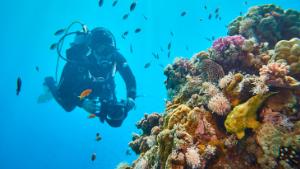Heat-resistant corals in the Middle East could save the world's dying reefs
(CNN)Coral reefs are in crisis. Around the world, they are being wiped out by rising sea temperatures -- a consequence of climate change.
But in one region, some corals are withstanding the heat.
Off the coast of the Arabian Peninsula, there are pockets of resistance. Consequently, this area has become a hotbed for research as marine biologists try to figure out what gives these corals their ability to survive warming seas and whether genetic technology could -- and should -- be used to save dying coral reefs, before we lose them forever.
Reef life
Corals are not only beautiful -- they are also a vital part of the marine ecosystem.
"Coral reefs are home to a quarter of all marine species and support fisheries by providing foraging habitats for adult fish and nursery habitats for juveniles," says John Burt, a marine biologist at NYU Abu Dhabi, in the United Arab Emirates. "So they're really important biologically and economically."
Although they look like plants, corals actually consist of tiny, soft-bodied creatures called polyps that cluster together in huge numbers to form colonies. In most coral species, the polyps secrete limestone which forms a hard skeleton. A reef is a collection of corals, which come in a dazzling array of shapes and sizes, and a glorious rainbow of colors.
However, it's not the coral itself that creates the brilliant hues, but colorful microscopic algae that live within the coral. "It's a win-win relationship," says Burt. The coral provides the algae with essential nutrients and a safe place to live, while the algae provides the coral with about 90% of its food.
But when sea temperatures reach a tipping point that relationship breaks down. "The coral is either digesting the algae or expelling it -- we're not quite sure of the process," says Burt. As the density of algae drops, the coral "bleaches" -- becoming progressively paler until it turns bone white.
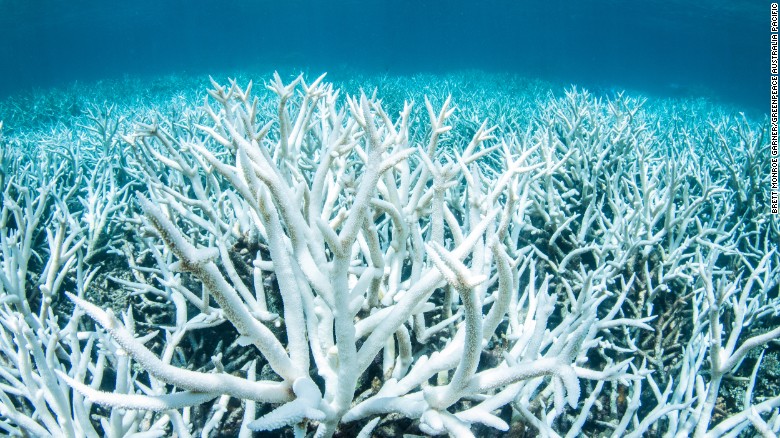
Bleached coral on Australia's Great Barrier Reef.
Bleaching does not spell instant death. "Like humans, corals deposit fats, so they can live for a short period of time off their fat reserves," says Burt. And if the hot spell subsides, he says, the coral can "pull algae back into their tissue" and revive. But if that doesn't happen within one to two weeks, the corals starve to death.
Between 2014 and 2017, corals around the world suffered the longest and most widespread bleaching event on record. In Australia, during 2016, 29% of the 3,863 reefs that comprise the world's largest coral reef system -- the Great Barrier Reef -- were severely damaged.
During this period, the corals in the Gulf of Aqaba -- a narrow finger of water at the northernmost tip of the Red Sea, bordered by Israel, Egypt, Jordan and Saudi Arabia -- appeared healthy. Jessica Bellworthy, from Israel's Bar Ilan University, says that although the Gulf is warming at a faster rate than the global average, mass bleaching has never been observed there.
Bellworthy is studying the Gulf of Aqaba's corals to find out just how resilient they are. "We tested the corals in the lab by raising the temperature by five degrees above the summer maximum of 27 degrees Celsius, and sustaining that for a number of weeks," she says.
In most places, corals start bleaching at one or two degrees Celsius above the maximum summer temperature, but the corals in Bellworthy's lab "still show resilience" even when subjected to these extreme increases.
An average global increase of five degrees Celsius in ocean temperature is "what we would expect to see towards the middle of the next century if we did nothing to reduce global gas emissions," she says.
Bellworthy subjected her corals to further tests by increasing the water's acidity. Climate change drives acidification, which does not cause bleaching but hampers the corals' ability to recover.
"The sea has a current pH level of 8.1," says Bellworthy, "and we anticipate that will decline to pH 7.8 by the end of the century. We've been lowering the pH of water in the tanks to that same level."
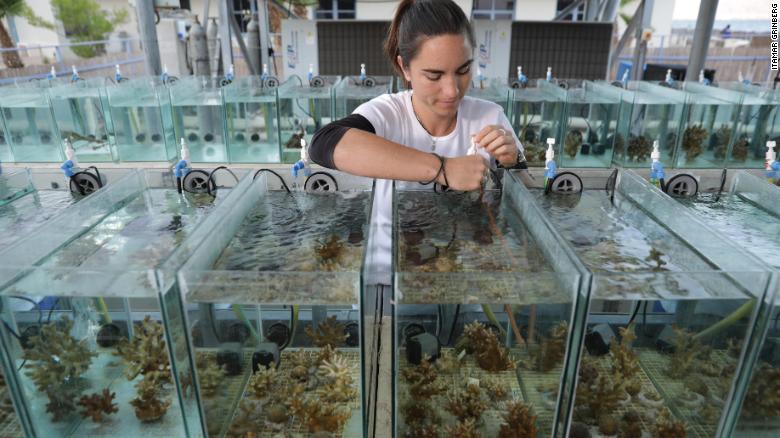
Jessica Bellworthy working with corals in her laboratory's Red Sea Simulator system.
Again, the Gulf of Aqaba's corals coped remarkably well. What makes them so hardy?
Bellworthy's supervisor, Professor Maoz Fine, has suggested that their remarkable resistance stems from the last Ice Age. "Sea levels were extremely low because much of the water was trapped in ice and the southern entrance to the Red Sea was blocked by a land barrier," explains Bellworthy. "The Red Sea was isolated, and became so hot and salty that most life died out," she says, adding that a gap in the fossil record supports this theory.
About 8,000 years ago, the ice melted, sea levels rose and water flooded back into the Red Sea, bringing organisms with it. But the entrance acted as a thermal bottleneck and only those species that could cope with super-heated water survived.
"With time these organisms stepping stoned their way north, up to the Gulf of Aqaba," says Bellworthy.
The Gulf of Aqaba is now relatively cool but, according to Fine's theory, the corals have retained their ancient ability to survive bath-warm temperatures. "The current temperatures are even a little suboptimal," says Bellworthy. "In some cases, the corals perform better at 1 to 2 degrees Celsius above the current summer maximum."
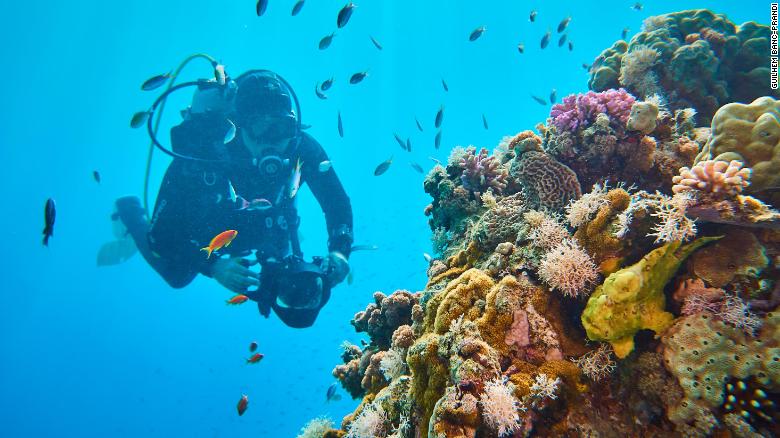
Jeremy Delafosse from the Energy Observer Project examing coral in the Gulf of Aqaba.
Bellworthy says that the Gulf of Aqaba corals have an unusually good chance of surviving global warming and protecting them is vital. In an effort to protect them from local pollution, which threatens them, she and her colleagues are seeking to achieve international recognition -- ideally UNESCO World Heritage Site status -- for the reefs.
Back from the brink
Further south, researchers at Saudi Arabia's King Abdullah University of Science and Technology (KAUST) are using genetic analyses to decipher why Red Sea corals are much less prone -- although not immune -- to bleaching, than the exact same species living on the Great Barrier Reef.
They are also comparing individual corals to determine why some show more heat tolerance than others. Once key lifesaving genes have been identified, the next step will be to breed the corals that carry them. "The question is: If we can identify the 'supermom' and 'superdad' corals, can we create 'superbabies' that will be more resilient to stressful conditions?" says Michael Berumen, who leads KAUST's Red Sea Research Center.
If we can identify the 'supermom' and 'superdad' corals, can we create 'superbabies'...?
Michael Berumen
The KAUST scientists are also examining the corals' microbiomes -- the bacteria, viruses and fungi that live in association with them. "Each individual coral may have up to a thousand types of bacteria living on or inside it. We don't yet know how important a role they play in heat resilience, but we assume it's significant," says Berumen.
In Abu Dhabi, Burt is conducting research in the southern Persian Gulf, the hottest coral reef habitat on the planet, where the sea temperature frequently hits a whopping 36 degrees.
"It's a natural laboratory for studying how coral reefs might respond to climate change," says Burt. "These corals exist in hotter conditions than are projected for at least another century in places like the Great Barrier Reef and the Caribbean."
Working with colleagues from the UK's University of Southampton, Burt's team examined the corals' algae component, and in 2015 discovered a new species of algae that dominates virtually all corals across the southern Persian Gulf.
The team named the algae Symbiodinium thermophilum -- thermophilum means "heat-loving."
"Over 99% of the algae in Persian Gulf corals are from this one species," says Burt, adding that he believes the algae enable the corals to survive the extreme environment.
It's possible, he says, that Symbiodinium thermophilum will spread to corals elsewhere, as ocean temperatures heat up. But natural processes are slow and climate change is occurring at an alarming rate.
Ethical dilemmas
Most marine biologists say that experimental measures being tested in the lab should not be deployed in the wild unless absolutely necessary and, even then, with extreme caution.
"Some scholars have talked about human-assisted migration -- moving heat-resistant corals from the southern Persian Gulf to other parts of the world," says Burt, "but we don't know the genetic implications, and there's a risk of introducing disease and parasites."
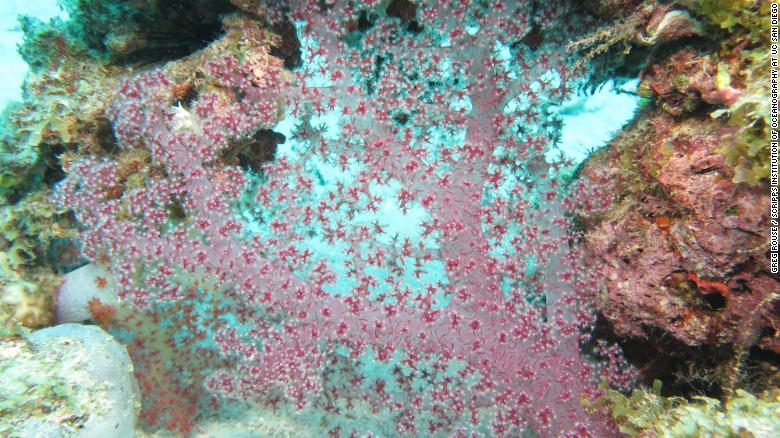
Soft coral.
And as with any genetic engineering technology, the application of breeding research could lead to unexpected pitfalls.
"Our remit as scientists is to say which options are on the table," says Berumen. "The real dilemma comes later in the form of the ethical question: Should we use these technologies or not?" He adds that good quality data that quantifies the pros and cons is key to decision making. Ultimately, though, "it is up to reef management authorities to decide what to do within their jurisdictions."
There is consensus among coral experts that we should do more to preserve the reefs we already have, rather than relying on a scientific fix.
At the moment, Berumen says he's not ruling anything out. "The situation is critical in some parts of the world and large areas of coral reef have been killed by climate change stress, so extreme options might need to be on the table."
News Courtesy: www.cnn.com

